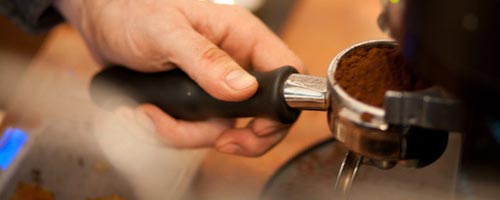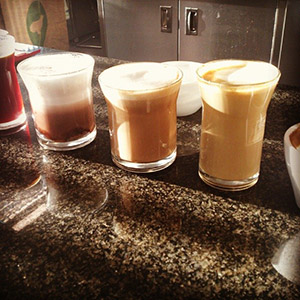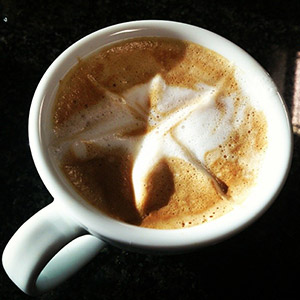A day on the Caffe Society barista course

One great service that we offer is our barista training.
The service is available to those who want to learn more about the beverage and become skilled in the art of coffee making and is something that we offer free of charge to all our commercial customers who purchase machines from ourselves. We sent our latest starter on one of these training courses and here are the results…..
“Truth be told, my experiences of making cups of coffee had been limited to putting a teaspoon of instant coffee in a mug, pouring in the boiling water from the kettle, adding some milk and sugar, stirring, and then drinking. So the idea that, in a few short hours, I would be making coffee with a traditional espresso machine and trying my hand at some latte art was, shall we say, a slightly daunting and seemingly impossible one. After all, my previous attempt on the office coffee machine brought about disastrous, bitter results.
Coffee was initially whipped up by the trainer, Domenico, who then proceeded to explain the different types of coffee machines that were available; allowing ourselves to understand the variances in regards to what they can and can’t do; we learnt how these are wired internally and how, simply put, the water gets from the water tank, through the pipes, coffee and finally into the cup. It was an informative talk that got everybody looking at how coffee is produced from the inside – certainly a different perspective on coffee making.
Once we’d been given a guided tour, it was time for a quick history lesson into how the caffeinated drink has been made over the years and the progress of the coffee machines from their very first iterations to the all signing and dancing electronically controlled beasts that they are today. After a quick quiz on what we’d learnt, and what we already knew, about the production of coffee (hint, coffee is a fruit!) it was time for business.
Our attentions then turned to the methodology behind the espresso.
The machine that we used on the morning was the flagship Astoria machine, the Easy Plus and whilst the technology inside would certainly help to produce quality coffee, there was still a lot that the user could do to get it wrong – as Dominico showed.
Shot after shot of coffee followed, each a bad one. As was explained, even the smallest discrepancy can cause variations in taste when the coffee is pulled.
First up, were the beans: With the traditional machines needing the beans to be ground Domenico went into detail on how a vital part of the process this is and then it was time to talk about pressure. If the group-handle was filled to the brim and compacted too tightly then the result was an overtly strong shot, one that sent the taste buds into unnecessary over-drive, etching an uncomfortable expression in the process. Conversely, if the handle was sparsely filled and loose, then there was no flavour extracted. Obviously knowing how to do it exactly was a dark art, one that thankfully does not require a scholarship to Hogwarts.
From then the conversation turned to brewing times and temperatures. Again it was explained, and demonstrated, how important it is to get things right.
Then, it was our turn. The beans were ground, the group-handle filled and compacted and connected to the heads and then, then it was time to press the button.
The results for us first-timers were pretty good!
It had been mentioned that the optimum time for an espresso to be made was between twenty and thirty seconds, depending who you listen to, but anything above or under this time-scale would yield bad coffee. Thankfully, everybody got the steps just right and the brewing period was, near enough, timed to perfection.
There was no chance to rest on any laurels though as the art of the espresso may have been mastered, it was time to move on towards the creation of a range of varieties of coffee based drinks such as lattes and cappuccinos. And for this, it was time to find out how to use the milk frother.
Initially I thought it wouldn’t be that hard to heat and froth milk, but then again, what did I know? My first attempt failed miserably. Instead of heating the milk into a froth, I managed not to really heat anything apart from the air in the container – no wonder why I was stood there a long time waiting for the thermometer to rise!
The others however weren’t as bad as myself and all managed to get things right. Then it was time to either pour the hot milk into the cups or, depending on how adventurous you were feeling, get a mixture of milk and foam into the mug to create your cappuccino. Needless to say, the technique needed to do so did not come naturally and on a first attempt, milk ended up on the floor instead of the cup! (It wasn’t my effort before you ask!)
Luckily however we were allowed a few chances to get things right before being individually put to the test.
In front of everybody we had to make two different types of coffee based drinks simultaneously. With the pressure on, would we be able to remember our training?

Well, did we? We certainly thought so!
After that it was time for some training in the more light-hearted side of barista theatrics, learning how to do some simple latte art. Sadly here the results corresponded to our artistic flair; mine, whilst aiming to be a star, ended up looking more like a splodge – as you can see below.

I then had to leave (after all, I had work to do!) whilst those carried on making coffee before learning about the importance of the cleaning and maintenance processes for these exquisite machines.
Asking a few questions to my fellow baristas-in-training afterwards it turned out that the split was fifty-fifty between those who were here in a commercial capacity and those who received entry to the course as a Christmas gift.
A great and enjoyable day that saw everybody from enthusiastic amateurs to people able to operate a top-of-the-range espresso machine and wield drinkable results. It is well worth enrolling on whether you are setting up a business and getting a traditional machine or if a passionate coffee lover, all are welcome, all have fun.”
To find out more about our bespoke barista training sessions and, hopefully, sign up for one, more information is available at this link
